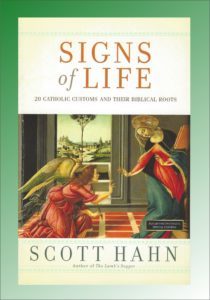Hahn Explains Catholic Practices

Scott Hahn.[1]2018. Signs of Life: 20 Catholic Customs and Their Biblical Roots. New York: Image.
Review by Stephen W. Hiemstra
As an author I have found that I learn more from my critics than from my friends. In my recent book, Simple Faith, my most influential reviews came from a retired, very-progressive professor who wanted nothing to do with endorsing the book, but his comments encouraged me to write about a half-a-dozen new essays. By contrast, I had trouble getting my evangelical friends to take time to read the book. In a similar fashion, Protestants have much to learn by reading books by Catholics.
Introduction
In his book, Signs of Life, Scott Hahn writes:
“Jesus had greater praise for simple believers and children than he had the intellectuals of his day…it’s a mistake to treat intelligence and piety as if they’re mutual exclusive terms…One of my goals in writing this book is to show how Catholic customs and devotions fit into the larger scheme of Christian faith.”(8-9)
As an ancient church, the Roman Catholic church has weathered modern and postmodern life with relatively few concessions to the craziness of our culture and with a respect for Christian spiritual practices that most Protestant church have either ignored or only recent started to embrace.
In my own pilgrimage, it is only the last three years that I have written about “Holy Saturday”, one of the days of Holy Week that Protestant usually have no clue about, which Catholics have long recognized and celebrated. Holy Saturday is a great day to reflect on grief, something not handled well by Americans and not officially recognized in the Protestant tradition. Hahn does not discuss it probably because he limited himself to the top 20 Catholic customs in need of clarity among Protestants.
Background and Organization
Scott Hahn is a well-known Catholic theologian and author who was raised as a Presbyterian. In my most recent book, for example, I cited Hahn’s (2009) work on covenants, which I read in seminary. Unfortunately, Hahn tells us relatively little about his conversion to Catholicism, but he does share that he is a Carmelite and a bit of what that means (140-142).
Hahn writes in twenty chapters, introduced with an introduction and followed by an epilogue:
Holy WaterThe Sign of the CrossBaptismThe MassGuardian AngelsAdvent and ChristmasConfirmationMarriagePriesthoodAnointing of the SickIncenseCandlesSacred ImagesRelicsFasting and MortificationConfessionIndulgencesIntercession of the SaintsThe RosaryScapulars and Metals(iii-iv).
This book is apparently an abridged version of an earlier book by the same name covering forty Catholic Customs (Hahn 2009). Seminary students will tell you that brevity is next to Godliness!
Sacraments and Sacramentals
Hahn distinguishes between a sacrament, something instituted by Christ, and a sacramental, instituted by the church. He writes:
“[A sacramental] is any object set apart and blessed by the Church to lead us to good thoughts and increase our devotion.”(12)
This is analogous to the role of a pastor, whose chief occupation is to point people to God, only a sacramental is a physical object. Thus, those nice little rocks that have a Bible verse painted on them that the ushers gave you on leaving church could be considered a sacramental, provided that they are properly blessed. This is similar to the story of Holy water (23) or maybe the practice of conducting prayer walks to bless an office or a home.
Biblical Interpretation
One of the weaknesses of the modern church is that the Bible has—among those paying attention—become too familiar. We read some passages more frequently than others and we focus on some words and skip quickly over others. Hahn’s willingness to point out the Biblical justification for the many Catholic spiritual practices therefore proved absolutely fascinating to me.
I have, for example, never really taken the idea of guardian angels very seriously. Hahn highlights the role of angels in various passages in the Book of Acts. For example, angels free the apostles from prison (Acts 5:19 and 13:7). He likens our guardians to being in charge of protecting God’s temple (1 Cor 3:16 and 6:19), much like the cherubim protect the Garden of Eden (Gen 3:24). If our bodies are a temple of the Holy Spirit, then this analogy makes perfect sense, but I never really thought about it even though these passages are very familiar.
Assessment
Scott Hahn’s book, Signs of Life, is a fascinating and accessible read. I received this book as a gift from a Catholic friend and will likely use it as a reference when questions come up.
References
Hahn, Scott W. 2009. Kinship by Covenant: A Canonical Approach to the Fulfillment of God’s Saving Promises. New Haven: Yale University Press.
Hahn, Scott W. 2009. Signs of Life: 40 Catholic Customs and Their Biblical Roots. New York: Image.
Hahn Explains Catholic Practices
Also See:
Pope and Contraception Get Second Look
Other ways to engage online:
Author site: http://www.StephenWHiemstra.net, Publisher site: http://www.T2Pneuma.com.
Newsletter: http://bit.ly/MayBe_2019
The post Hahn Explains Catholic Practices appeared first on T2Pneuma.net.



